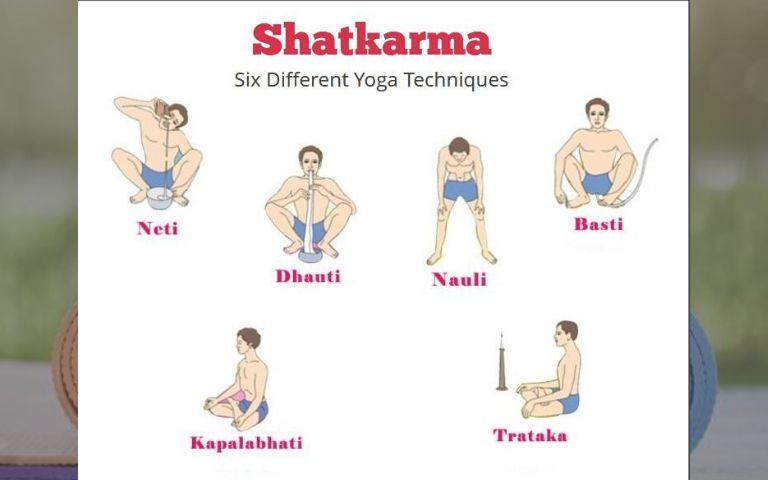
Shatkarma
As we know, most of our understanding about the concepts, psychology, philosophy and methodology of yoga comes from the Yoga Sutras of Patanjali. In the sutras, Patanjali provides us with the eight limbs of yoga by practicing which one can attain self-realization. From the point of view of practicing yoga, the three most important limbs are asana (physical sitting posture), pranayama (breathing practices) and meditation. In this approach, one has to find a very comfortable and steady sitting posture, practice some pranayama and finally sit in meditation for long periods of time. It is only through deep states of meditation that one can attain the state of “seedless samadhi” which leads to self-realization.
While trying to implement the guidelines provided by Patajali, the yogis realized that in order to sit motionless in one position for a long time, one requires a body that is strong, flexible and steady and a mind that is free of any agitation or negativity. It is this need that lead to the evolution of the whole science of Hatha Yoga comprising various practices for asana, pranayama, mudra etc. One of the most important texts on yoga practices is the Hatha Yoga Pradipika (HYP). This text provides information and instructions on asana, pranayama, mudra, bandha, meditation etc. The practice of Pranayama involves a variety of breathing techniques which help cleanse and energize the body. Under the category of pranayama, the text also lists six cleansing techniques, called “shat-karma”, which help cleanse the entire internal system of the body. The idea is that the body needs to be clean internally, free of ailments and imbalances, for the pranayama to be fully effective.
In the HYP, the following two verses introduce the Shatkarma practices:
“When fat or mucus is excessive, shatkarma, the six cleansing techniques,
should be practiced before pranayama. Others, in whom the doshas, i.e. phlegm (kapha), wind (vata) and bile (pitta), are balanced need not practice them.” (verse 2.21)
“Dhauti, basti, neti, trataka, nauli and kapalabhati; these are known as
shatkarma or the six cleansing processes.” (verse 2.22)
As you will notice, in the verse 2.21, the three terms vata, pitta and kapha, called doshas (humors) have been used. As you may recognize, these are concepts which are predominantly used in the science of Ayurveda. In the HYP, concepts from Ayurveda and, of course, the Kundalini tantra, have been freely integrated with the traditional Hatha Yoga practices. As almost all of us have some level of imbalance among the three doshas, we all need to integrated these cleansing practices into our yoga routine.
I am presenting below a brief overview of the six cleansing practices.
Dhauti
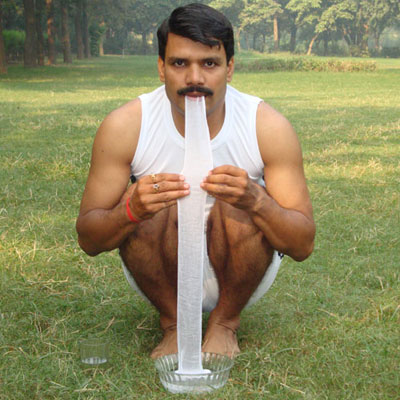
Vastra-dhauti (cloth)
In the HYP, the dhauti practice that is described is commonly known as “vastra dhauti” (cloth cleansing):
“A strip of wet cloth, about two inches wide and about 10 feet in length is slowly swallowed and then taken out, as instructed by the guru. This is known as dhauti.” (verse 2.24)
For the dhauti practice, you’ll need the required piece of cloth, about two inches wide and ten feet long. The cloth has to be thoroughly cleaned by boiling it in clean water and then needs to be swallowed while still quite wet.
As stated in the verse, vastra dhauti must be practiced under the guidance of a qualified teacher. Unfortunately, it is not easy to find a teacher who is well versed in the practice. As such, to my knowledge, very few people seem to practice this on a regular basis. I tried it only once many years ago when I was in India. However, after swallowing only 2-3 inches of the cloth, I gave up as I just couldn’t continue to swallow the cloth. If you do a search on Youtube, you will find many videos demonstrating this practice. Those who do it routinely claim many benefits from the practice.
HYP mentions only vastra dhauti (cloth cleansing) as the internal cleansing practice. However, another ancient text called “Gherand Samhita” lists many more practices under the category of dhauti. A few of these that are more commonly practiced are:
vārisāra (śaṅkhaprakṣālana) (internal cleansing with water)
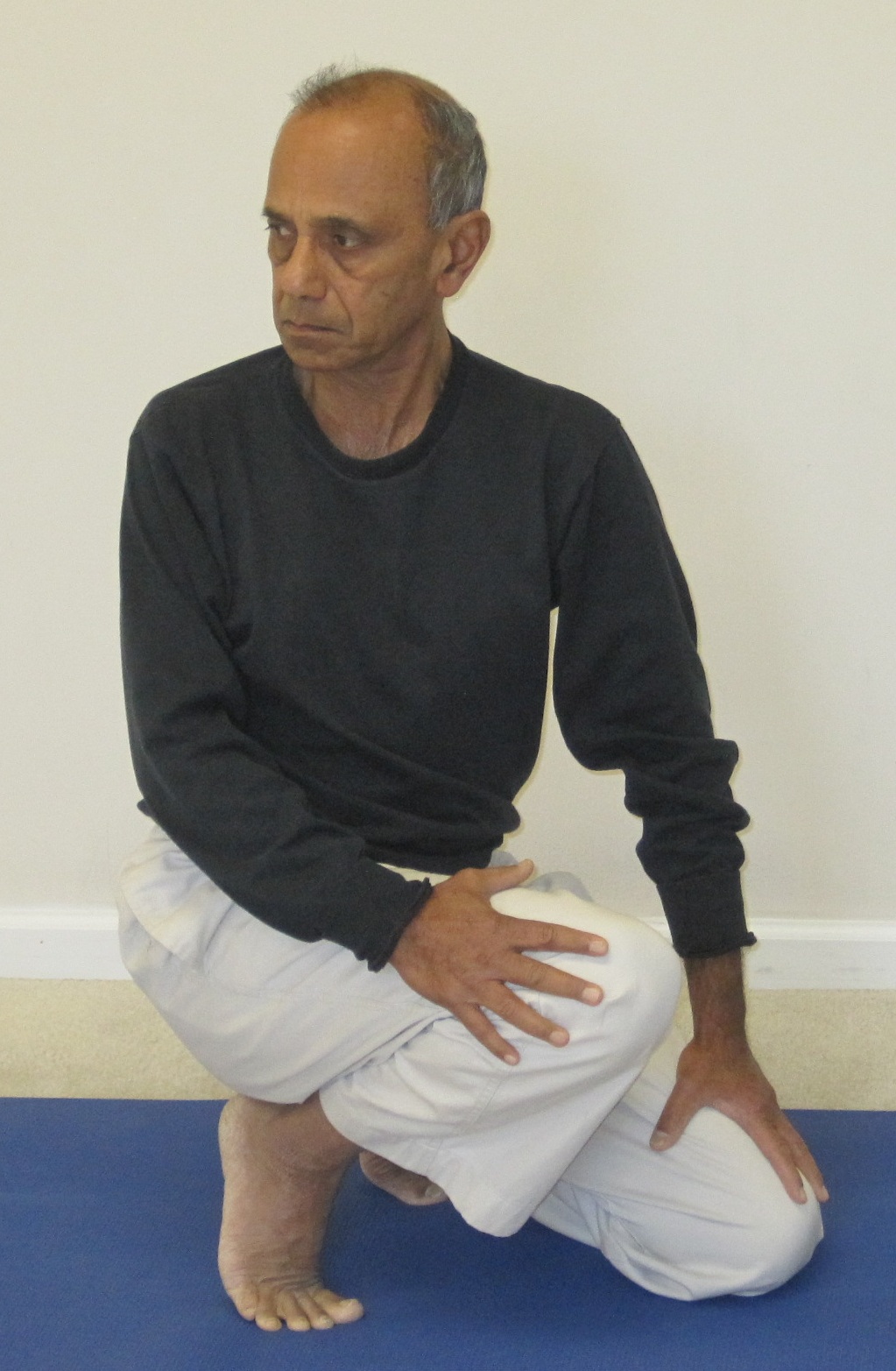
Udarakarshana (LSP)
The word vāri means water and sāra literally means “essence”. Here, the word implies the use of water for this cleansing practice. This is perhaps the most popular of the various internal cleansing techniques mentioned in the Gherand Samhita. Also, the version that is most commonly practiced is the one given in the yoga texts from the Bihar School of Yoga. There are two versions of the practice – the full version and the short version (laghu śaṅkhaprakṣālana, commonly referred to as LSP). The practice is done first thing in the morning on an empty stomach. In the full version, you drink two glasses of lukewarm, saline water and then perform five specific asanas as described in the text. You may need to repeat the cycle a couple of more times until you get the urge to go for the bowel movement. After the bowel movement, you repeat this process several times until what comes out through the anus is pure, clean water. Usually, this involves drinking about 15-16 glasses of water and can take up to 3 hours or longer. This practice does a very thorough cleansing of the entire internal system and can be considered a “major operation”. You need to follow the diet guidelines given in the text “very rigorously”, both before and for a week after the practice.
The short version, LSP, is simply to do the practice as mentioned above until you are done with the first bowel movement.
I have two articles on my blog on this practice:
- Laghu Shankha Prakshalana (colon cleanse – short version)
- My experience with Shankhaprakshalan (Deep Colon cleanse)
Please read these blog posts to get detailed instructions on the practice. Be sure to read some of the comments from the readers about their own experience with the practice.
In the following verse, HYP lists the benefits of the dhauti practice:
“There is no doubt that coughs, asthma, diseases of the spleen, leprosy and twenty kinds of diseases caused by excess mucus (kapha dosha) are destroyed through the effects of dhauti karma.” (HYP 2.25)
vahnisāra (agnisāra) (igniting internal fire) dhauti (also known as agnisāra kriyā)

Agnisara kriya
The words “agni” and “vahni” both mean fire in Sanskrit. The practice of agnisāra helps ignite internal fire called jaṭharāgni (fire in the stomach or digestive fire) in Sanskrit. agnisāra can be considered as an extension of pranayama practices that involve breath retention (kumbhaka) and application of the bandhas (locks). The practice can be done either in the standing or a seated position. I prefer to do it in the standing position. It is done by expelling all the air from the lungs, applying both the chin lock (jālandhara bandha) and the abdominal lock (uḍḍiyāna bandha), and then, while holding the breath, moving the navel toward the spine and back out in brisk, sharp and forceful movements.
Visit my blog here for the post entitled “Improve Digestion with Agnisara Kriya” which gives detailed instructions on the practice of agnisāra kriyā.
vamana dhauti (kuñjara kriyā) (voluntarily induced vomiting)
Vamana is a Sanskrit word which means vomiting. This practice is also known as Kunjara (sometimes spelt as kunjala) Kriya or Gaja karani. Both kunjara and gaja mean an elephant. In the science of Ayurveda, vamana is one of the five practices popularly known as “pancha karma”.
In the practice of vamana dhauti, you first drink about 4-6 glasses of lukewarm, saline water. Let the water sit in the stomach for a few minutes. Then you can perform a few movements of the agnisara kriya mentioned above. Then, by putting the first two fingers at the base of the throat, you vomit the water out. The practice offers several benefits – stimulate the working of lungs, kidneys and the heart; from an Ayurvedic perspective, it removes the imbalance of kapha and pitta doshas; and remove excess mucus from the stomach lining.
Basti
Basti (enema) is one of the common practices mentioned in Ayurveda as a part of treating imbalance in the various doshas. The practice prescribed in the HYP involves standing in the Utkatasana (half squat) in water, inserting a clean, lubricated catheter into the anus, performing nauli kriya (mentioned below) and sucking the water into the body. After some time, you will get the urge to go to the toilet for bowel movement. In the more advanced version of the practice, one can develop the skill to suck the water in through the anus without the use of the catheter.
As you can see, this is not an easy technique to practice These days the practice that is commonly used is the regular enema. Herein, a container with lukewarm water, medicated or otherwise, is used. The nozzle at the other end of the long tube that is connected to the container is inserted into the anus which allows the water to get into the system. You need to stay in the reclining position for some time until you get the urge to evacuate.
Neti
Neti is practiced to cleanse the nasal passage. It is one of the highly recommended practices to guard against seasonal allergies like hay fever, pollen etc. There are two techniques of neti commonly practiced – sutra neti (neti with a thread) and jala neti (neti with water).
Sutra Neti
The technique given in the HYP is the “sutra neti” (neti with a thread). Traditionally, a cotton thread about a foot in length is used. The thread should be clean, sterilized and lubricated with ghee (clarified butter). There are two ways to do the practice. In the technique mentioned in the HYP, you pour the thread in through one nostril and then pull it out through the mouth. Then you are supposed to massage the passage gently with the thread and then take the thread out. You will then need a second thread and repeat the process through the other nostril.
In the second approach to this practice, the thread is inserted through one nostril and then taken out from the other nostril. Again, you need to massage the passage with the thread for some time before taking the thread out.
These days, it is much more common to use a thin catheter instead of the cotton thread for the neti practice. The catheter must be clean and lubricated with ghee before using it.
Jala Neti
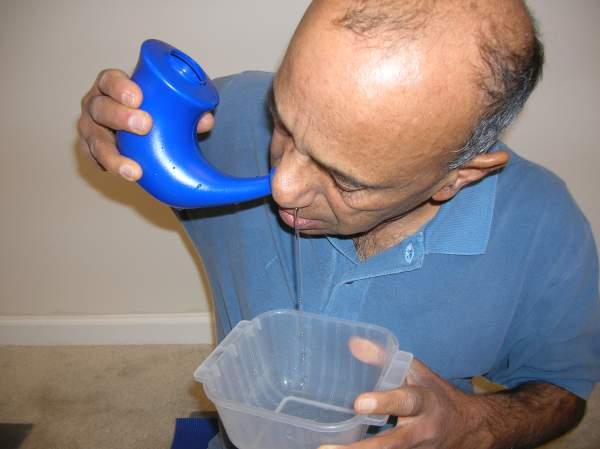
Jala Neti (nasal rinse)
Even though Jala Neti is not mentioned in the HYP, it is described in other ancient texts including the Gherand Samhita. Since the practice of sutra neti is not very comfortable for most people, jala neti (water neti) has become very popular these days. The practice of jala neti requires a “neti pot” which has a nozzle that can fit comfortably in the nostril. These pots are available in multiple shapes and sizes. A wide choice of materials is also available – copper, stainless steel, plastic, ceramic etc. Clean, lukewarm and lightly salted water is used for the practice. The water temperature and the saltiness should match those of human tears for best results. Here is the practice in brief:
The nose cone is inserted into one nostril and the position of the head and pot is adjusted to allow the water to flow out of the other nostril. Whilst the water is flowing through the nasal passages one breathes through the mouth. After half a pot has flowed in one direction, the water flow is reversed. When the water in the pot is finished, the nose must be properly dried.
Visit my blog here for a detailed description of Jala Neti. The article includes details of the technique, benefits, precautions etc. A video demonstration of the practice is also included.
Trataka
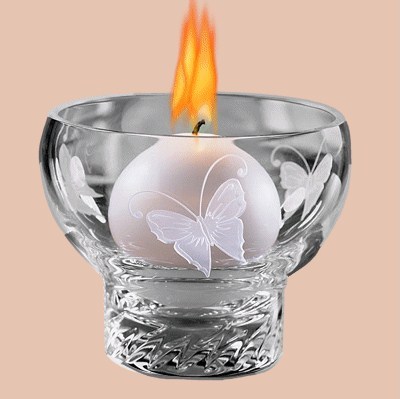
Trataka (candle gazing)
The word trāṭaka means gazing intently at an object. HYP defines it as follows:
“Looking intently with an unwavering gaze at a small point until the eyes begin to water is known as trataka by the acharyas (teachers).” (HYP 2.31)
Although not mentioned in the HYP, most commentators suggest two forms of the practice – external gaze and internal gaze. Almost any object can be used for the purpose of holding the gaze – image of a deity, yantra, mandala, symbol of OM, a tree, distant clouds, rising and setting sun, a candle flame etc. Of these, the most commonly used object for gazing is a candle flame. The other commonly used object is the rising or the setting sun. Because of its size and the intensity of its glow, gazing at the sun is very effective in maintaining the internal gaze for a long time which can help in getting into a deeper state of meditation.
Even though trataka is mentioned as a cleansing practice in the texts, over the years, as the practice has evolved, it is now commonly used as a meditation practice. The practice develops a deep sense of focus and concentration and can bring the mind into the state of ekāgratā (one-pointedness). Thus, it becomes very effective as a form of dharana practice which can lead to deeper states of meditation (dhyana). Many authors recommend the practice to open the third eye (the ajna chakra) located at the spot between the two eyebrows which can bring about clarity and purity of the mind.
A brief description of the practice using the flame of a candle is given below:
Position a lighted candle at the eye level at a distance of about 3-5 feet from you. You should face the candle directly without having to turn the neck. Keeping the body straight and still, gaze at the candle flame until the eyes begin to water. At that point close the eyes and begin to gaze at the internal image of the flame that will stay in your eye’s inner view for some length of time. When the inner image fades away, stay still for some more time with your focus on your breathing. You may repeat the whole technique at least one more time.
Visit my blog here where you will find a description of the trataka practice including detailed instructions, its benefits and precautions.
Nauli

Nauli (abdominal churning)
The HYP defines Nauli as follows:
“Leaning the shoulders forward, protrude the abdominal muscles and rotate the muscles from right to left and left to right with speed. This is called nauli by the siddhas.” (HYP 2.33)
In the Gheranda Samhita, it is known as Lauliki.
Nauli (abdominal churning) is a practice that involves control of the abdominal muscles and moving the muscles in either a boat-like side-to-side movement or a full rotational movement. The practice is done while holding the breath after expelling all the air from the lungs. The technique involves protruding the middle part of the abdomen, called the “rectus abdominis”, sucking the sides of the abdomen in and then performing the nauli movements.
Here is a brief description of the practice:
- Come to a standing position with the feet about shoulder-width apart.
- Bending the knees slightly, position the hands on the knees or slightly higher on the thighs.
- After inhaling half-way, eliminate all the air from the lungs by exhaling forcefully and completely.
- While holding the breath out, apply the Uddiyana bandha (navel lock) by sucking the belly in toward the spine and also apply the Jalandhara bandha (chin lock).
- The remaining steps could take some training and practice to get them right.
- Try to protrude the rectus abdominis muscles out while sucking the sides of the belly in creating what is called the “madhyama nauli” (central nauli).
- At this point you can do two different movements – side-to-side movement resembling a rocking boat and rotational movement. When you move the muscles to the right, it is called “dakshina nauli” (nauli to the right) and when you move them to the left, it is called “vama nauli” (nauli to the left). By doing these movements alternately creates the boat-like rocking movement.
- When you have the urge to inhale, release the bandhas and come back up to a standing position and take a few deep breaths to normalize your breathing. You may like to repeat this procedure one more time.
- The other technique that is commonly practiced is to create a circular, rotational movement of the muscles while still holding the breath. You can do one cycle clockwise and then repeat the same movement counterclockwise.
- As before, after doing the full cycle, release the locks and come up to a standing position. You may repeat the sequence one more time.
The benefits of nauli are given in the following verse:
“Nauli is the foremost of the hatha yoga practices. It kindles the digestive fire, removing indigestion, sluggish digestion, and all disorders of the three doshas (vata, pitta, kapha), and brings about happiness.” (HYP 2.34)
For a demo of the practice, you may like to visit some of the many videos available on youtube.
I plan to write a blog post on nauli in the near future.
Kapalabhati
Even though listed under the category of “shatkarma” cleansing practices in the HYP, Kapalabhati is now almost universally practiced as a part of pranayama techniques. It is considered to be a very energizing, detoxifying and cleansing practice. The word kapalabhati is a composite of two Sanskrit words – “kapala” and “bhati”. Kapala means the skull or the forehead area and bhati means to glow or shine. Because of its cleaning properties, regular practice of kapalabhati can bring about a natural glow on your face. For this reason, it is also known as the “skull shining” pranayama.
The technique involves forcing the breath out in short bursts while at the same time sucking the belly in with a sharp movement. In this practice, the emphasis in entirely on exhalation. The inhalation is allowed to happen passively, without any force or sound, after each expulsion of breath. You my start with a speed of about 60 breaths per minute and practice 40-50 breaths in a round. Try to build your practice up to three rounds with a brief gap between rounds. Gradually, with practice, you can increase both the speed and the number of breaths per round.
Visit the following two posts on my blog for detailed instructions on the practice:
Kapalabhati (skull shining) pranayama
Summary
According to the HYP, “By practicing the shatkarmas one is rid of obesity and is freed from imbalances of the the three doshas. Then pranayama is practised and success is achieved without effort.” (2:36)
The three doshas, as mentioned above, are mucus (kapha), bile (pitta) and wind (vata). When the doshas are imbalanced, the energy gained through pranayama practice will be “wasted” in rectifying these disorders. In fact, if you have any mucus blockages it may even prevent you from practicing pranayama. By practicing shatkarmas, you will be able to create a balance among the three doshas, and eliminate the toxins from your system. When assimilation and excretion are properly established, Pranayama becomes more effective in maintaining a healthy body.
Is any of the Shatkarma practices part of your yoga routine? Please share your experience below.
GRACIAS.
Great information.
Namaste
Thanks for your kind feedback.